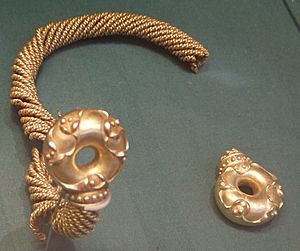Sedgeford Torc facts for kids
Quick facts for kids The Sedgeford Torc |
|
|---|---|
 |
|
| Material | Gold |
| Created | 200BC-50BC |
| Period/culture | Iron Age, La Tène |
| Place | Sedgeford |
| Present location | Room 50, British Museum, London |
| Registration | 1968,1004.1 |
The Sedgeford Torc is a special gold necklace from the Iron Age. It was found near a village called Sedgeford in Norfolk, England. A "torc" is a stiff necklace or bracelet, often made of twisted metal.
This torc was found in two main parts. The biggest part was discovered in 1965. Later, in 2004, the missing end piece was found. Today, you can see the Sedgeford Torc at the British Museum in London.
Contents
What is the Sedgeford Torc?
The Sedgeford Torc is a very old piece of jewelry. It was made between 200 BC and 50 BC. This means it is over 2,000 years old! It is made from many thin gold wires twisted together.
How the Torc Was Made
Making this torc was a lot of work. First, 48 tiny gold wires were twisted into pairs. This made 24 thicker wires. Then, three of these paired wires were twisted together again. This created a thicker "rope" of gold. Eight of these gold ropes were then twisted to form the main part of the torc. In total, about 25 meters of gold wire were used!
The ends of the torc are hollow and shaped like rings. They were made using a method called "lost wax casting." This is where a wax model is covered in clay, heated to melt the wax, and then molten metal is poured into the empty space. The ends are decorated in a style called La Tène style. This art style uses swirling patterns and circles.
Similar Gold Torcs
The Sedgeford Torc looks a lot like other gold torcs found in England. Some famous ones are the Snettisham Great Torc and the Ipswich torcs. These are also displayed at the British Museum. The Sedgeford Torc is so similar to the Newark Torc that they might have been made by the same person!
Why Was It Buried?
The torc was not lost by accident. It was buried on purpose, probably around 75 BC. When valuable items are buried like this, they are called a "hoard." We don't know exactly why it was buried. It might have been broken before it was buried, or it could have broken later when farmers were ploughing the field.
How the Torc Was Found
The main part of the Sedgeford Torc was found on May 6, 1965. Dr. Bernard G. Campbell, the landowner, found it in a field. He saw it stuck to a farm tool called a "harrow." A harrow is used to break up and smooth soil.
The First Discovery
The harrow only went a few inches deep. This means the torc was probably brought closer to the surface by earlier, deeper ploughing. The place where it was found is only two miles from where the large Snettisham Hoard was discovered. The Snettisham Hoard also included many gold torcs.
The torc was declared "treasure trove." This means it was an old, valuable item found hidden, and its owner was unknown. The British Museum bought the torc. The person who found it, a farmworker named A. E. Middleton, was given money for finding it. A copy of the torc was made for the Norwich Castle Museum.
Finding the Missing Piece
Many years later, in Easter 2004, the missing end of the torc was found. It was discovered during an archaeological survey. This survey used metal detectors to search the field. Dr. Steve Hammond, a retired chemistry teacher, found the piece. He found it about 400 meters away from where the main part was found.
This missing piece was also declared treasure trove. It was bought for the British Museum and put back together with the rest of the Sedgeford Torc. Now, the complete Sedgeford Torc can be seen by everyone at the British Museum.

